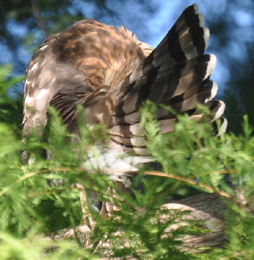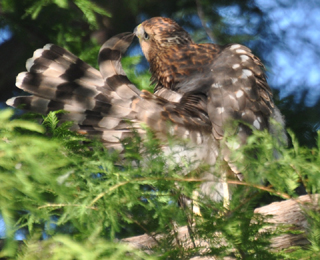|
July 15, 2015
Meet Louise! At least, we think this fledgling is the lone female in the bunch. At those rare moments when we have seen all four of them at the same time, one is noticeably larger than the others, so it's likely this is a female. Typically, the majority of hawklets in a brood are male, so this is what might be expected.
In additon to overall size, this cooplet has large legs (tarsi) and a prominent profile that may indicate larger size of culmen (line from tip of beak to feathers). These are two of the factors to consider in speculating this young hawk is female.
July 16, 2015
Today I spotted this young hawk (likely a male, based on size) perched in the sun on Rufous' favorite limb. He did not notice me, so I photographed him as I watched him preen. The cooplets' eyes are beginning to turn from blue-grey to yellow, as they mature into juvenile hawks. Notice the hawklet's eye in the middle photo. He has "blinked" with his nictitating membrane, a second translucent eyelid that slides from front to back.
 First the hawklet reaches around to his preen gland (uropygial gland), located at the base of his tail. First the hawklet reaches around to his preen gland (uropygial gland), located at the base of his tail.
|
 Then he applies the oil to feathers all over his body, realigning the tiny feather components (barbules) as he goes. Then he applies the oil to feathers all over his body, realigning the tiny feather components (barbules) as he goes.
|
Continue to Chapter 24: Learning to Hunt
[TABLE OF CONTENTS]
|